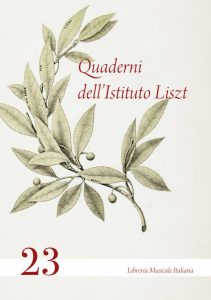SAGGI
Carlida Steffan
Gli album di Sofia de’ Medici: profilo di una nobile dilettante di musica
Patrick Barbier
Lettres de Pauline Viardot: nouvelles acquisitions de la FondazioneIstituto Liszt Francesco Monti Il tardo Liszt: Historische ungarische Bildnisse, S. 205. Una riflessione sulla genesi e la struttura armonica
 INTERVENTI
INTERVENTI
Cecilia Raunisi
Johannes Brahms e Clara Schumann: storia di un carteggio e di una moderna edizione
RICORRENZE
Mariateresa Storino
Nel nome di Liszt. Venticinque anni di ricerca e attività su e attorno a Franz Liszt
RECENSIONI
Robert Schumann. Diari (1828-1830), traduzione a cura di Nicoletta Lagna, Barletta, Cafagna, 2021 (Maria Teresa Arfini)
ANNA QUARANTA, La fantasia op. 17 di Schumann. Sonate o fantasie: che importa il nome!, Lucca, LIM, 2022 (Elisabetta Fava) Oltre la diva. Presenze femminili nel teatro musicale romantico, a cura di Angela Annese e Lorenzo Mattei, Bari, Cacucci, 2023 (Livio Aragona)
ABSTRACTS
Carlida Steffan
The albums of Sofia de’ Medici. Profile of an amateur noble musician
Albums — collections of musical autographs compiled from the first decades of the nineteenth century by members of the upper classes — are valuable sources to reconstruct the parlour music practices and the relationships interwoven within private society. Recent acquisitions by the Istituto Liszt Foundation through the antiques market include some musical autographs — songs and piano pieces — that were in the album of Sofia de’ Medici, daughter of Gian Giacomo, Marquis of Marignano. This paper aims to reconstruct the biography of the amateur noble musician, a composer and pianist also appreciated by Liszt during his stay in Milan. It also traces the possible framework of social, cultural and musical relations — including Donizetti, Nini, Bazzini, Verdi, Belgiojoso — that converged between the 1830s and 1840s within the private cultural space of the Marquises of Marignano.
Patrick Barbier
Letters from Pauline Viardot: New acquisitions of the Istituto Liszt Foundation
Some unpublished letters by Pauline García Viardot (1821-1910), sister of Maria Malibran and an established singer who performed in European theatres and in her private salon, have been purchased through the antiques market by the Istituto Liszt Foundation, which now holds them in its archive. The transcript and commentary of Pauline’s letters, provided here for the first time, show a dense network of contacts with the protagonists of the European artistic world. Her salon, frequented by the best society of the time, was a meeting place for the artistic, cultural and political elite, also helping to launch the career of young composers and singers. A polyglot and cosmopolitan personality, composer, organizer of musical après-midis, Pauline shared her interest in the music of the past with other composers of the time, and worked actively to save it from oblivion.
Francesco Monti
Late Liszt: Historische ungarische Bildnisse, S. 205. A reflection on the genesis and the harmonic structure
This paper focuses on Franz Liszt’s late piano production. The period investigated is between 1877 and 1885, the years devoted to the episodic writing of the Historische ungarische Bildnisse, S. 205. Firstly, the genesis of the musical text is examined through the epistolary, contemporary contacts with publishers, copyists and the Hungarian nobility, then the cycle is analyzed from a harmonic-compositional perspective under the investigative lens of the ‘popular’ and the ‘non-Western’, in search of indigenous Hungarian national inflections together with the possible presence in the score of non-European elements of an exotic nature, specifically in the harmonic and melodic fabric.